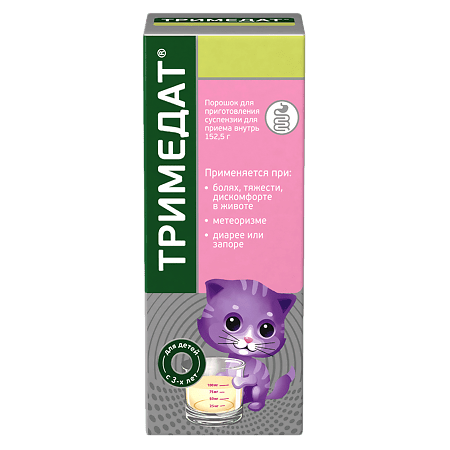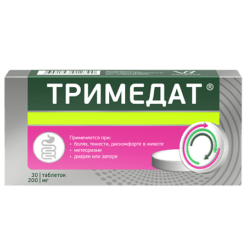No products in the cart.
Trimedat, 152, 5 g
€23.74 €19.78
Description
Pharmacotherapeutic group: antispasmodic agent
ATC code: A03AA05
Pharmacological properties
Pharmacodynamics<
Trimebutin, acting on the encephalinergic system of the intestine, is a regulator of its peristalsis. Acting on peripheral δ-, μ- and k-receptors, including those located directly on the smooth muscles throughout the gastrointestinal (GI) tract, it regulates motility without affecting the central nervous system. Thus, trimebutine restores normal physiological activity of gastrointestinal musculature (esophagus, stomach, intestines, biliary tract) in various GIT diseases associated with motility disorders (has a stimulating effect in hypokinetic states and spasmolytic in hyperkinetic states).
Normalizing visceral sensitivity, trimebutine provides analgesic effect in abdominal pain syndrome.
Pharmacokinetics
Trimebutin is rapidly absorbed from the GI tract after oral administration. Maximum concentration (Cmax) in blood plasma is reached after 1-2 hours. Bioavailability is 4-6%. Volume of distribution (Vd) is 88 l. The degree of binding to plasma proteins is low – about 5%. Trimebutine penetrates through the placental barrier to a small extent. Trimebutine is biotransformed in the liver and excreted in the urine mainly as metabolites (about 70% during the first 24 hours). The active metabolite of trimebutine is desmethyltrimebutine. The elimination half-life (T1/2) is about 12 h.
Indications
Indications
Symptomatic treatment of pain, cramps and discomfort in the abdomen, sensation of bloating (flatulence), intestinal motor disorders with changes in stool frequency (diarrhea or constipation), dyspepsia, heartburn, belching, nausea, vomiting associated with functional diseases of the gastrointestinal tract and biliary tract (non-erosive form of gastroesophageal reflux disease, cholelithiasis, dysfunction biliary tract, irritable bowel syndrome, sphincter of Oddi dysfunction, postcholecystectomy syndrome).
Postoperative paralytic ileus.
Pharmacological effect
Pharmacological effect
Pharmacotherapeutic group: antispasmodic
ATX code: A03AA05
Pharmacological properties
Pharmacodynamics
Trimebutine, acting on the enkephalinergic system of the intestine, is a regulator of its peristalsis. Acting on peripheral δ-, μ- and k- receptors, including those located directly on smooth muscles throughout the gastrointestinal tract
no-intestinal tract (GIT), it regulates motility without affecting the central nervous system. Thus, trimebutine restores the normal physiological activity of the gastrointestinal tract muscles (esophagus, stomach, intestines, biliary tract) in various gastrointestinal diseases associated with motility disorders (it has a stimulating effect in hypokinetic conditions and an antispasmodic effect in hyperkinetic ones).
By normalizing visceral sensitivity, trimebutine provides an analgesic effect for abdominal pain syndrome.
Pharmacokinetics
After oral administration, trimebutine is rapidly absorbed from the gastrointestinal tract. The maximum concentration (Cmax) in blood plasma is achieved after 1-2 hours. Bioavailability is 4-6%. Distribution volume (Vd) – 88 l. The degree of binding to plasma proteins is low – about 5%. Trimebutine penetrates the placental barrier to a small extent. Trimebutine is biotransformed in the liver and excreted in the urine mainly in the form of metabolites (approximately 70% during the first 24 hours). The active metabolite of trimebutine is desmethyl trimebutine. The half-life (T1/2) is about 12 hours.
Special instructions
Special instructions
A course of treatment for irritable bowel syndrome in the acute period at a dose of 600 mg per day for 4 weeks and continuation of treatment after the course at a dose of 300 mg per day for 12 weeks helps to avoid relapse of the disease.
Patients with diabetes mellitus should pay attention to the sucrose content in the drug. One single dose of the finished suspension, containing 25 mg of the active substance, contains 3.1 g of sucrose, which corresponds to 0.3 bread units (XU).
Impact on the ability to drive vehicles and machinery
The drug does not have a sedative effect, does not affect the speed of the psychomotor reaction and can be used by people of various professions, including those requiring increased attention and coordination of movements. However, given the possible side effects that may affect these abilities (dizziness and others), caution should be exercised when driving vehicles and engaging in other potentially hazardous activities.
Active ingredient
Active ingredient
Trimebutine
Composition
Composition
active ingredient: trimebutine – 1.2 g;
excipients: sucrose, poloxamer 188 (micronized), polysor-bat-80, betacarotene, orange flavor.
Pregnancy
Pregnancy
Experimental studies did not reveal data on the teratogenicity and embryotoxicity of trimebutine. However, due to the lack of necessary clinical data, the use of the drug during pregnancy is contraindicated.
It is not recommended to prescribe the drug during lactation due to the lack of reliable clinical data confirming the safety of use during this period. If it is necessary to use the drug during breastfeeding, breastfeeding should be stopped.
Contraindications
Contraindications
Hypersensitivity to the components included in the drug.
Sucrase/isomaltase deficiency, fructose intolerance, glucose-galactose malabsorption.
Children under 3 years of age.
Pregnancy.
With caution
Patients with diabetes mellitus should be careful due to the presence of sucrose in the composition of the drug (see section “Special instructions”).
The drug should be used with caution during breastfeeding, as there is no data on its ability to pass into breast milk.
Side Effects
Side Effects
The side effects listed below are presented in accordance with the following gradations of frequency of their occurrence: very often (≥1/10); often (≥1/100, <1/10); uncommon (≥1/1000, <1/100); rare (≥1/10000, <1/1000); very rare (< 1/10000) (including isolated reports); frequency is unknown (it is not possible to determine the frequency of occurrence based on available data).
From the digestive system: frequency unknown – dry mouth, unpleasant taste, diarrhea, dyspepsia, nausea, constipation.
Allergic reactions: frequency unknown – skin rash.
From the nervous system: frequency unknown – drowsiness, fatigue, dizziness, headache, anxiety.
From the genitourinary system: frequency unknown – menstrual irregularities, urinary retention.
Other: frequency unknown – painful enlargement of the mammary glands.
Interaction
Interaction
No drug interactions have been described.
Overdose
Overdose
There have been no cases of overdose with the use of trimebutine to date.
Treatment: discontinuation of the drug, gastric lavage, administration of activated charcoal, symptomatic therapy. There are no specific antidotes.
Storage conditions
Storage conditions
In the original packaging (bottle in a pack) at a temperature not exceeding 25 °C.
Store the prepared suspension for no more than 14 days at a temperature not exceeding 25 °C and for no more than 28 days at a temperature of 2 to 8 °C.
Keep out of the reach of children.
Shelf life
Shelf life
2 years.
Do not use after the expiration date indicated on the package.
Manufacturer
Manufacturer
Abdi Ibrahim Ilach Sanayi ve Tij. A.Sh., Türkiye
Additional information
| Shelf life | 2 years. Do not use after the expiration date stated on the package. |
|---|---|
| Conditions of storage | In the original package (bottle in a package) at a temperature not exceeding 25 °С. Prepared suspension should be stored at the temperature max. 14 days at 25 °С and max. 28 days at 2 to 8 °С. Keep out of reach of children. |
| Manufacturer | Abdi Ibrahim Ilyac Sanayi ve Tij. A.S., Turkey |
| Medication form | Powder for oral suspension |
| Brand | Abdi Ibrahim Ilyac Sanayi ve Tij. A.S. |
Other forms…
Related products
Buy Trimedat, 152, 5 g with delivery to USA, UK, Europe and over 120 other countries.

















